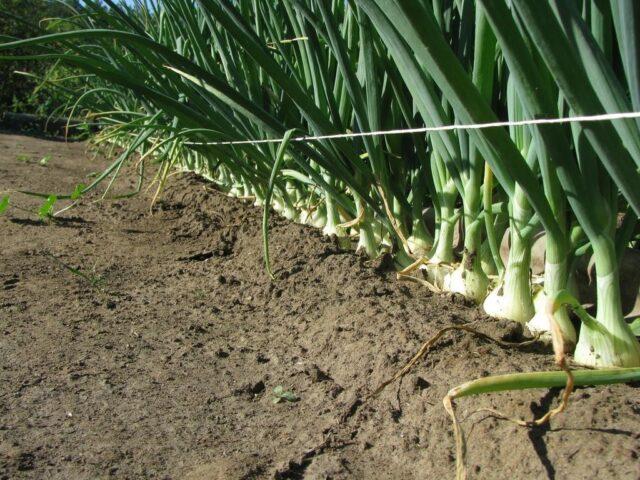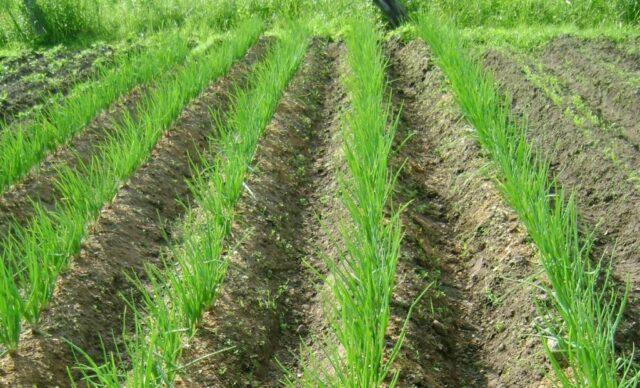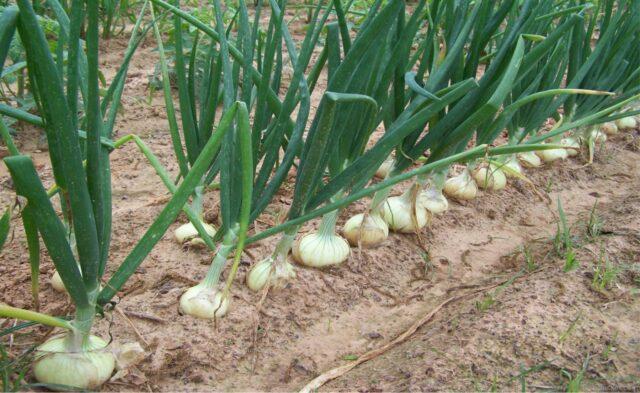Content
The Chinese method of planting onions helps gardeners grow a healthy crop. It is more time consuming but leads to better results. Subject to all the rules of agricultural technology and proper care, the bulbs grow large and strong, with a pleasant, slightly sweetish taste. The sevok, planted according to the technology developed by the Chinese, shows a high yield even in a small area, is perfectly stored, and is suitable for transportation.

The Chinese method of planting onions involves planting it not on a flat area, but in ridges prepared in advance
Description of the Chinese way of growing onions
Planting onions using Chinese technology has relatively recently begun to be used by Russian gardeners and summer residents. But judging by the numerous reviews about this method of growing a crop, those who have tried to apply it at least once in practice no longer return to the traditional method. The essence of this technique lies in the special preparation of the site, the seed is sown in the earthen ramparts formed with the help of a hoe, which are separated from each other by grooves.
Usually in Russia potatoes and some root crops are planted this way. A Chinese-grown vegetable quickly gains mass and yields a higher yield. Since the bulbs receive more heat on a hill, they become as strong and resistant to diseases common among the culture as possible, as well as to adverse conditions. The distance between the ridges makes it much easier to care for the plant: it is convenient to loosen and water the beds, nutrients are not washed out of the embankment, which reduces fertilizer consumption. Experts note that the yield of onions planted in Chinese, even on poor soil, increases by 20%, and in cities of the middle zone - by 40%. In addition, it is very convenient to extract fruits from the comb, the harvesting process is simple and takes little time. After ripening, the bulbs are dried in the sun, which increases their shelf life. In terms of taste, the vegetable remains the same as with the usual planting technique, but its shape becomes a little flattened, which does not affect the quality in any way.
Pros and cons of Chinese onion planting
Compared to the traditional onion planting method, the Chinese technology has several advantages and only one disadvantage.

Regardless of the type of onion planted according to the Chinese method, the fruits grow large
Pros:
- uniform ripening;
- large size;
- high productivity;
- ease of carrying out agrotechnical works;
- persistent immunity to diseases;
- good keeping quality;
- minimal risks of pest damage;
- ease of harvesting.
Disadvantages:
- strict adherence to the cleaning period.
Planting onions according to the Chinese method
In order for the harvest of Chinese-planted onions to meet expectations, you need to strictly follow the technological process. It is important to observe the planting dates, properly prepare the material, adhere to the bulb planting scheme. The main feature of the method is the placement of the seedlings on the ridges, therefore, the beds should be properly prepared before the procedure.
Landing dates
To plant onions in the Chinese way, you should wait until the earth warms up to + 5-10 ° С. Most often this happens at the end of April or at the beginning of May. In regions with warm climatic conditions a little earlier than in central Russia.

The culture is planted on the beds on the days recommended by the sowing calendar
Sevka preparation
Planting onions in the Chinese way involves the use of sets. Before carrying out the procedure, it should be sorted. If the bulbs are needed for forcing greens, use a large set with a diameter of more than 15 mm. Small bulbs from 11 to 15 mm in diameter are suitable for growing turnip.
Half a month before planting, the selected onions folded in a cardboard box should be dried in the sun or near a battery for 10-12 hours, at a temperature not higher than 40 ° C. This is done to protect the seedlings from shooters, downy mildew and neck rot. Before planting onions in Chinese, it should be peeled from excess husk and carefully cut off dry tails. The day before planting, the seedlings need to be soaked for 24 hours in heated to 40 0With water. In order for the bulbs to germinate faster, you can add a little slurry to the container; Fitosporin-M will help to protect the culture from rot.
Site preparation and ridges
The Chinese technique of planting onions implies the correct preparation of the site. Already from the middle of autumn, the beds need to be dug up, distributing superphosphates, dolomite flour and Nitroammofosk on their surface, 1 tbsp will be needed per square meter of land. l, 2 tbsp. l and 1 tsp. drugs, respectively. In the spring, the site is again dug up with the addition of nitrogen fertilizers, then longitudinal ridges are formed on the bed at a distance of 30 cm from each other, 15 cm high.

Chinese onions are best planted in the beds after tomatoes, cabbage, cucumbers or legumes
Landing scheme
Prepared planting material is planted on a warm, windless day. The sevok is lowered into the ground 3 cm deep, preferably without pressing. Better to put the onion on a comb and sprinkle it with earth. So the root system of the culture will develop faster. The distance between the bulbs, which is provided by the Chinese planting technology, should be 12-15 cm. In June, the ridges are opened - they dig out the seedlings to 2/3 of the height, removing excess soil in the aisles.
Care features
Growing onions in Chinese is not much different from the standard method, but many gardeners note that this technology is much easier. The culture does not need regular watering and weeding, as well as protection from diseases. Procedures are performed only if necessary.

For Chinese technology, it is best to take a set of categories II and III.
Watering
The first time the beds are watered immediately after planting the onions. Further moistening of the soil is carried out as the earth dries up. Usually, during the first month of crop growth, two abundant waterings are carried out. It is not recommended to overflow the beds if the spring was rainy, you can not do any moistening at all.
Weeding, loosening
Ridge beds with onions rarely need weeding. Weeds are pulled out as they emerge. Loosening is performed after each watering, the procedure helps to prevent the appearance of insects.
Top dressing
The Chinese version of onion cultivation involves applying fertilizers three times:
- Two weeks after planting, the culture is fed with organic matter. Diluted chicken droppings or a 10% mullein solution with the addition of 3 tbsp. l. urea per 10 liters of water.
- In the second half of June, urea (15 g), phosphorus and potassium dressings (40 g each) are used as fertilizers. The preparations are dissolved in a bucket of water.
- At the time of the formation of the turnip, the beds are watered with diluted potash and phosphorus fertilizers (15 and 25 g per 10 liters of water, respectively).
A bucket of formula is usually distributed over 4 square meters. m. landing.
Disease and pest control
Every summer resident knows that it is easier to prevent a plant disease than to treat an already developed disease later. Therefore, in order to prevent infection and protect the crop, a number of procedures should be followed when growing Chinese onions. Powdery mildew is considered the most common plant ailment, therefore, onion beds should be sprayed from time to time with a solution of copper sulfate (7 g per bucket of water). In addition, you need to properly prepare the planting material.
After harvesting, all plant residues should be destroyed from pests, crop rotation should be observed, and the crop should not be grown on the same bed several times in a row. To avoid being attacked by an onion fly, the soil must be loosened regularly.

For a healthy harvest, sow strong bulbs.
Conclusion
The Chinese method of planting onions is gaining more and more popularity among summer residents every year. The technology is simple, it has a lot of advantages, it makes it easier to care for the crop. Onions are a very healthy vegetable that is used daily in the kitchen and is included in most hot and cold recipes. Each gardener strives to increase the yield of this culture.
Reviews of the Chinese method of planting onions








